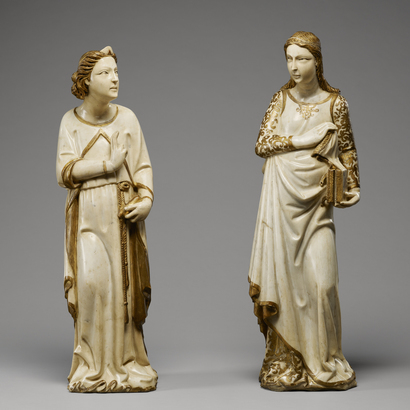The “Annunciation” refers to the moment in the New Testament when an angel pays a visit to a young woman of Nazareth and “announces” that she will give birth to the child of God. The angel is Gabriel. The child is Jesus. The woman is Mary, or Maria, or Miriam. Greeks call her Theotokos, or “God-bearer.” Muslims recognize Maryam, for the episode is recorded in the Koran. Generations of Catholic schoolchildren, hastily praying the Hail Mary, called her “Holy-Mary-Mother-of-God”—and the words of the prayer, murmured in church or declaimed over the school P.A. system, are the ones Gabriel is said to have uttered 2,000 years ago: “Hail Mary, full of grace, the Lord is with thee.”
The Getty Museum, in Los Angeles, recently acquired a remarkable late-Gothic work by Giovanni di Balduccio, The Annunciation (circa 1334), which is now on view. It is a sculptural pair: angel and Virgin, carved from white marble, approximately 30 inches high. They are counterparts: the angel glancing upward, the Virgin downward; his right hand gesturing toward her in appointment, hers drawn back in acceptance.
The moment in the New Testament when an angel pays a visit to a young woman of Nazareth.
The two figures have “a fascinating history,” Anne-Lise Desmas, head of Sculpture and Decorative Arts at the Getty, told me. They originally faced each other from opposite sides of the arched entry to the main chapel of the pontifical fortress in Bologna. After the French invaded Italy in 1796, they wound up in private hands—and eventually in the collection of Adrienne “Suzy” Mante, a niece of Marcel Proust’s. In 1950 they were acquired by the New York–based French dealer Daniel Wildenstein.
This Annunciation is distinctive when compared to those we’re more familiar with. The Pietro Cavallini (circa 1296), in the Basilica of Santa Maria, in the Trastevere area of Rome, is a tiled two-dimensional drama: the angel swoops in on the Virgin, who sits fixedly on a pillared throne and presses her right hand to her sternum as if to say, “Who, me?” In Leonardo da Vinci’s Annunciation (circa 1472–75), set in an enclosed garden, Gabriel commands with an upraised right arm and the seated Mary straightens her back, a gesture of surprise and obedience at once. And the Botticelli in the Metropolitan Museum of Art (circa 1485–92) is a pas de deux in a Renaissance palazzo, angel and Virgin kneeling in courtly deference to each other. The Giovanni di Balduccio Annunciation,however, is an annunciation unto itself. The figures are relaxed and fully embodied. Standing free, without setting or ornament, interacting in a display case or in digital space, they look at each other directly, joined in the recognition that the news he brings her is good news. —Paul Elie
